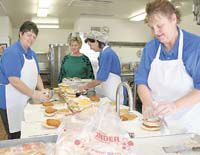| School district food service director Sharon Patten watches as Valerie Shannon, Linda Bergamo and Louann Birch stack spicy chicken sandwiches for students at Mont Harmon Junior High. The Carbon School District food service program serves 2,450 meals per day to youth in the local public education system. |
A lot has changed in public education during the last 30 years. Schools have moved from slide rules to computers. Concurrent enrollment in high school and colleges, once a rarity, has become common.
The growth of technology has changed class offerings so much that students from the 1960s would not recognize the courses.
And along with the many changes, school lunch or food service has evolved,
School prepared meals have been around a long time. Lunches were born during the Great Depression of the 1930s. The program’s offerings and complexity have grown beyond what its originators imagined.
For Carbon County residents who grew up in the middle part of the last century, school lunch was pretty much a set thing. All students got the same food, regardless of likes or dislikes.
But today, the program provides students with several food choices.
Educators and researchers have determined that hungry students don’t learn well. So a well-fed school populace is important.
Everyday, the Carbon School District lunch program serves 2,450 meals. That adds up to a total of 475,000 per year. With the inclusion of breakfast programs in the 1990s, the district also serves 900 morning meals per day.
Securing and overseeing the preparation of the food is Sharon Patten’s job.
“All the menus in the district are analyzed and we are audited by the federal government concerning what we serve,” said Patten, who has worked in the food service supervisory position for 18 years. “I plan the meals about a month ahead, depending on what we have available from the warehouse.”
The district prepares all meals in the schools, except for a few that are transported from Carbon High to the Lighthouse program each day. The food served to students comes from a cooperative that includes 11 other districts in the state.
“We work to provide meals that are low in fat and high in fiber,” said Patten.
The district focuses on fruits and vegetables for elementary students and all meals are set to standards of no more than 30 percent total fat and 10 percent saturated fat.
“We do use a lot of prepared food in our kitchens as well. I like the fact that we use no raw meat in our operation,” added the program director.
Davis School District, which is part of the cooperative, has helped rural public schools by stockpiling supplies and preparing some food before it is sent to other operations.
Carbon District presently has the lowest price for lunches in the state, noted Patten. Elementary students pay $1.10, junior high youth $1.25 and high school attendees pay $1.50 for a noon time meal.
At present all the elementaries serve the same menu on the any one day while the junior highs offer more choices. The high school offers many choices at a “help yourself” bar.
“One of the things we have to do is to cycle the menu based on what kids will eat,” said Patten. “What we have on the plate also depends on what is in season.”
The food service department has 31 employees with a food operations manager in each school. People who do this kind of work, Patten says, tend to stay with it.
“Generally there is little turnover in the positions,” she said, pointing out however that she lost four people last year, which is unusual. “People like these jobs.”
A visit to Mont Harmon’s kitchen that same morning showed that was true. The three women working there, Valerie Shannon, Linda Bergamo and Louann Birch, were all busy putting together some spicy hot chicken sandwiches for the lunch hour, while they talked happily about the day.
Included in the lunch menu that day was pizza, which comes from one of the local pizzerias.
“That gets bid out each year,” said Patten as she pulled carts out of a nearby cooler. “The vendor who wins the bid has to supply pizza that meets our fat content and nutrition requirements.”
While some politicians in the country have decried the growth of breakfast programs in schools, Patten thinks they are a pretty good idea.
“Every school in our district has one,” she said. “And I think they area positive addition to the school program.”
Free and reduced priced lunches are offered to a great many students in Carbon County, and to add to that the district also runs a summer lunch program as well.
“There are a lot of misunderstandings about that program,” said Patten. “Where those summer lunch programs take place is based on how much of the schools regular attendance during the year qualifies for free and reduced lunch. If 50 percent or greater of the regular student body qualifies for free or reduced lunches we will then, by application from the school, provide a summer lunch program.”
In past years that program has been offered at the Castle Valley Center, Petersen Elementary, Sally Mauro Elementary and Wellington Elementary.
“The thing that people need to know is that those summer lunches are available to anyone under the age of 18, no matter where they are from or what their socio-economic group is,” stated Patten.
Running a program with that many meals being service over a 40 mile geographical span would seem daunting to a lot of people, but Patten sees the job as being a lot of fun.
“I can’t say I have any real challenges here,” she states. “This is a lot of fun and I love to come to work every day.”

